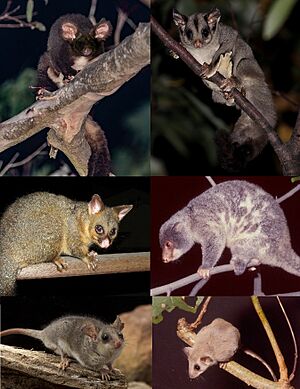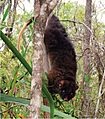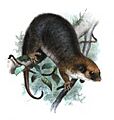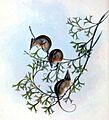List of phalangeriformes facts for kids

Phalangeriformes are a group of amazing marsupial mammals found in Australia, New Guinea, and Indonesia. You might know some of them as possums, gliders, or cuscus. These animals are part of a larger group called Diprotodontia, which is the biggest group of marsupials alive today.
You can usually find Phalangeriformes living in forests, but some also live in shrublands and grasslands. They come in all sizes! The tiny Tasmanian pygmy possum is only about 5 centimeters (2 inches) long, plus its tail. The biggest ones are the cuscus from the Spilocuscus group, which can be up to 64 centimeters (25 inches) long, with a tail almost as long! Most of these animals love to eat leaves, fruit, and insects. But many are omnivores, meaning they'll also eat small animals or other plants.
It's hard to know exactly how many of some Phalangeriformes species there are. For those we do know, their numbers can range from just 50 to 75,000 adults. Luckily, no species in this group have completely disappeared in recent times. However, some are in trouble. Four species are considered endangered, meaning they are at high risk of extinction: the Tate's triok, mahogany glider, Gebe cuscus, and Woodlark cuscus. Even more are in critical danger, with eight species listed as critically endangered. These include the Leadbeater's possum, northern glider, western ringtail possum, mountain pygmy possum, Talaud bear cuscus, Telefomin cuscus, black-spotted cuscus, and blue-eyed spotted cuscus.
There are 64 different types of Phalangeriformes alive today. Scientists group them into six main families, which are then put into two bigger groups called superfamilies: Petauroidea and Phalangeroidea. Scientists are always learning more about these animals, even finding some extinct species from the past!
Contents
Understanding Conservation Status
When you see the conservation status for these animals, it comes from the International Union for Conservation of Nature (IUCN) Red List of Threatened Species. This list helps us understand how safe or endangered an animal species is. We also try to show where each animal lives using maps. If there isn't a map, we'll describe their home range.
How Phalangeriformes Are Grouped
The Phalangeriformes are divided into two main superfamilies, each with different families of animals. This helps scientists organize and understand all the different types of possums, gliders, and cuscuses.
Superfamily Petauroidea
This superfamily includes four families: Acrobatidae, Petauridae, Pseudocheiridae, and Tarsipedidae.
Acrobatidae: The Tiny Gliders
This family has two species, both known for their amazing gliding abilities.
- Feathertail glider (Acrobates pygmaeus)
- Size: 6–8 cm (2–3 in) long, plus a 7–8 cm (3 in) tail.
- Home: Forests in Eastern Australia.
- Diet: Mostly honeydew (a sweet liquid from plants) and insects.
- Status: Least Concern (LC). Their population is stable.
- Feather-tailed possum (Distoechurus pennatus)
- Size: 10–12 cm (4–5 in) long, plus a 6–12 cm (2–5 in) tail.
- Home: Forests in New Guinea.
- Diet: Nectar, pollen, insects, and soft fruits.
- Status: Least Concern (LC). Their population is stable.
Petauridae: More Gliders and Trioks
This family has eleven species, including several types of gliders and trioks.
- Great-tailed triok (Dactylopsila megalura)
- Size: 17–32 cm (7–13 in) long, plus a 16–40 cm (6–16 in) tail.
- Home: Forests in Central New Guinea.
- Diet: Insects, fruit, and leaves.
- Status: Least Concern (LC). Population change is unknown.
- Long-fingered triok (Dactylopsila palpator)
- Size: 17–32 cm (7–13 in) long, plus a 16–40 cm (6–16 in) tail.
- Home: Forests in Central New Guinea.
- Diet: Insects, fruit, and leaves.
- Status: Least Concern (LC). Population change is unknown.
- Striped possum (Dactylopsila trivirgata)
- Size: 17–32 cm (7–13 in) long, plus a 16–40 cm (6–16 in) tail.
- Home: Forests in New Guinea and northeastern Australia.
- Diet: Ants, termites, and larvae.
- Status: Least Concern (LC). Their population is declining.
- Tate's triok (Dactylopsila tatei)
- Size: 17–32 cm (7–13 in) long, plus a 16–40 cm (6–16 in) tail.
- Home: Forests in Eastern New Guinea.
- Diet: Insects, fruit, and leaves.
- Status: Endangered (EN). Population change is unknown.
- Leadbeater's possum (Gymnobelideus leadbeateri)
- Size: 15–17 cm (6–7 in) long, plus a 14–18 cm (6–7 in) tail.
- Home: Forests in Southern Australia.
- Diet: Insects, spiders, and sap.
- Status: Critically Endangered (CR). Population is declining, with 1,100–11,000 individuals.
- Biak glider (Petaurus biacensis)
- Size: 12–32 cm (5–13 in) long, plus a 15–48 cm (6–19 in) tail.
- Home: Forests in Northwestern New Guinea.
- Diet: Sap, flowers, nectar, pollen, insects, spiders, and small vertebrates.
- Status: Least Concern (LC). Population change is unknown.
- Mahogany glider (Petaurus gracilis)
- Size: 12–32 cm (5–13 in) long, plus a 15–48 cm (6–19 in) tail.
- Home: Forests in Northeastern Australia.
- Diet: Nectar, pollen, and insects.
- Status: Endangered (EN). Their population is declining.
- Northern glider (Petaurus abidi)
- Size: 12–32 cm (5–13 in) long, plus a 15–48 cm (6–19 in) tail.
- Home: Forests in Northern New Guinea.
- Diet: Sap, flowers, nectar, pollen, insects, spiders, and small vertebrates.
- Status: Critically Endangered (CR). Their population is declining.
- Squirrel glider (Petaurus norfolcensis)
- Size: 12–32 cm (5–13 in) long, plus a 15–48 cm (6–19 in) tail.
- Home: Forests in Eastern Australia.
- Diet: Insects, gum, sap, nectar, pollen, and seeds.
- Status: Least Concern (LC). Their population is declining.
- Sugar glider (Petaurus breviceps)
- Size: 12–32 cm (5–13 in) long, plus a 15–48 cm (6–19 in) tail.
- Home: Forests and savannas in New Guinea and northern, eastern, and southern Australia.
- Diet: Sap, pollen, nectar, insects, spiders, and small vertebrates.
- Status: Least Concern (LC). Their population is stable.
- Yellow-bellied glider (Petaurus australis)
- Size: 27–30 cm (11–12 in) long, plus a 42–48 cm (17–19 in) tail.
- Home: Forests in Eastern Australia.
- Diet: Nectar, pollen, sap, insects, spiders, grubs, and small vertebrates.
- Status: Near Threatened (NT). Their population is declining, with 50,000–500,000 individuals.
Pseudocheiridae: Ringtail Possums and Gliders
This family has eighteen species, mostly ringtail possums and some gliders.
Hemibelideinae
- Lemuroid ringtail possum (Hemibelideus lemuroides)
- Size: 30–38 cm (12–15 in) long, plus a 30–35 cm (12–14 in) tail.
- Home: Forests in Northeastern Australia.
- Diet: Leaves.
- Status: Near Threatened (NT). Their population is stable.
- Southern greater glider (Petauroides volans)
- Size: 30–48 cm (12–19 in) long, plus a 45–55 cm (18–22 in) tail.
- Home: Forests in Southeastern Australia.
- Diet: Eucalyptus leaves.
- Status: Vulnerable (VU). Their population is declining, with 50,000–500,000 individuals.
Pseudocheirinae
- Rock-haunting ringtail possum (Petropseudes dahli)
- Size: 33–38 cm (13–15 in) long, plus a 20–27 cm (8–11 in) tail.
- Home: Rocky areas in Northern Australia.
- Diet: Leaves, fruit, flowers, and termites.
- Status: Least Concern (LC). Population change is unknown.
- Common ringtail possum (Pseudocheirus peregrinus)
- Size: 30–35 cm (12–14 in) long, plus a 30–35 cm (12–14 in) tail.
- Home: Forests and savannas in Eastern and Southern Australia.
- Diet: Eucalyptus leaves, flowers, buds, nectar, and fruit.
- Status: Least Concern (LC). Their population is stable.
- Western ringtail possum (Pseudocheirus occidentalis)
- Size: 28–40 cm (11–16 in) long, plus a 28–36 cm (11–14 in) tail.
- Home: Forests and savannas in Southwestern Australia.
- Diet: Leaves, fruit, flowers, bark, and sap.
- Status: Critically Endangered (CR). Their population is declining, with only 3,400 individuals.
- Daintree River ringtail possum (Pseudochirulus cinereus)
- Size: 16–40 cm (6–16 in) long, plus a 15–47 cm (6–19 in) tail.
- Home: Forests in Northeastern Australia.
- Diet: Leaves and fruit.
- Status: Near Threatened (NT). Their population is declining, with 20,000–100,000 individuals.
- Herbert River ringtail possum (Pseudochirulus herbertensis)
- Size: 30–40 cm (12–16 in) long, plus a 29–47 cm (11–19 in) tail.
- Home: Forests in Northeastern Australia.
- Diet: Leaves.
- Status: Least Concern (LC). Their population is stable.
- Lowland ringtail possum (Pseudochirulus canescens)
- Size: 16–40 cm (6–16 in) long, plus a 15–47 cm (6–19 in) tail.
- Home: Forests in New Guinea.
- Diet: Leaves and fruit.
- Status: Least Concern (LC). Their population is declining.
- Masked ringtail possum (Pseudochirulus larvatus)
- Size: 16–40 cm (6–16 in) long, plus a 15–47 cm (6–19 in) tail.
- Home: Forests in Eastern New Guinea.
- Diet: Leaves and fruit.
- Status: Least Concern (LC). Their population is declining.
- Painted ringtail possum (Pseudochirulus forbesi)
- Size: 16–40 cm (6–16 in) long, plus a 15–47 cm (6–19 in) tail.
- Home: Forests in Eastern New Guinea.
- Diet: Leaves and fruit.
- Status: Least Concern (LC). Population change is unknown.
- Pygmy ringtail possum (Pseudochirulus mayeri)
- Size: 16–40 cm (6–16 in) long, plus a 15–47 cm (6–19 in) tail.
- Home: Forests in Central New Guinea.
- Diet: Leaves, ferns, pollen, fungus, moss, and lichens.
- Status: Least Concern (LC). Their population is declining.
- Vogelkop ringtail possum (Pseudochirulus schlegeli)
- Size: 16–40 cm (6–16 in) long, plus a 15–47 cm (6–19 in) tail.
- Home: Forests in Western New Guinea.
- Diet: Leaves and fruit.
- Status: Vulnerable (VU). Their population is declining.
- Weyland ringtail possum (Pseudochirulus caroli)
- Size: 16–40 cm (6–16 in) long, plus a 15–47 cm (6–19 in) tail.
- Home: Forests in Western New Guinea.
- Diet: Leaves and fruit.
- Status: Least Concern (LC). Population change is unknown.
Pseudochiropsinae
- Coppery ringtail possum (Pseudochirops cupreus)
- Size: 28–41 cm (11–16 in) long, plus a 25–38 cm (10–15 in) tail.
- Home: Forests and grasslands in Central New Guinea.
- Diet: Leaves and fruit.
- Status: Least Concern (LC). Their population is stable.
- D'Albertis's ringtail possum (Pseudochirops albertisii)
- Size: 28–41 cm (11–16 in) long, plus a 25–38 cm (10–15 in) tail.
- Home: Forests in Western and Northern New Guinea.
- Diet: Leaves and fruit.
- Status: Near Threatened (NT). Their population is declining.
- Green ringtail possum (Pseudochirops archeri)
- Size: 28–41 cm (11–16 in) long, plus a 25–38 cm (10–15 in) tail.
- Home: Forests in Northeastern Australia.
- Diet: Leaves and figs.
- Status: Near Threatened (NT). Their population is declining, with 100,000 individuals.
- Plush-coated ringtail possum (Pseudochirops corinnae)
- Size: 28–41 cm (11–16 in) long, plus a 25–38 cm (10–15 in) tail.
- Home: Forests in Central New Guinea.
- Diet: Leaves and fruit.
- Status: Near Threatened (NT). Their population is declining.
- Reclusive ringtail possum (Pseudochirops coronatus)
- Size: 28–41 cm (11–16 in) long, plus a 25–38 cm (10–15 in) tail.
- Home: Forests in Western New Guinea.
- Diet: Leaves and fruit.
- Status: Vulnerable (VU). Their population is declining.
Tarsipedidae: The Honey Possum
This family has only one species, the unique honey possum.
- Honey possum (Tarsipes rostratus)
- Size: 6–9 cm (2–4 in) long, plus a 7–11 cm (3–4 in) tail.
- Home: Shrublands in Southwestern Australia.
- Diet: Pollen and nectar.
- Status: Least Concern (LC). Their population is stable.
Superfamily Phalangeroidea
This superfamily includes two families: Burramyidae and Phalangeridae.
Burramyidae: Pygmy Possums
This family includes the tiny pygmy possums.
- Mountain pygmy possum (Burramys parvus)
- Size: 10–12 cm (4–5 in) long, plus a 13–16 cm (5–6 in) tail.
- Home: Shrublands in Southeastern Australia.
- Diet: Insects, spiders, seeds, and berries.
- Status: Critically Endangered (CR). Their population is declining.
- Eastern pygmy possum (Cercartetus nanus)
- Size: 7–10 cm (3–4 in) long, plus a 7–11 cm (3–4 in) tail.
- Home: Forests and shrublands in Southeastern Australia.
- Diet: Nectar, pollen, and insects.
- Status: Least Concern (LC). Their population is declining.
- Long-tailed pygmy possum (Cercartetus caudatus)
- Size: 8–11 cm (3–4 in) long, plus a 12–16 cm (5–6 in) tail.
- Home: Forests and shrublands in New Guinea and northeastern Australia.
- Diet: Nectar, insects, and pollen.
- Status: Least Concern (LC). Their population is stable.
- Tasmanian pygmy possum (Cercartetus lepidus)
- Size: 5–7 cm (2–3 in) long, plus a 6–8 cm (2–3 in) tail.
- Home: Forests and shrublands in Southern Australia.
- Diet: Nectar, pollen, invertebrates, and small lizards.
- Status: Least Concern (LC). Their population is stable.
- Western pygmy possum (Cercartetus concinnus)
- Size: 6–11 cm (2–4 in) long, plus a 5–11 cm (2–4 in) tail.
- Home: Forests and shrublands in Southern and Southwestern Australia.
- Diet: Nectar, insects, and small lizards.
- Status: Least Concern (LC). Their population is stable.
Phalangeridae: Cuscus and Brushtail Possums
This family includes many types of cuscus and brushtail possums.
Ailuropinae
- Sulawesi bear cuscus (Ailurops ursinus)
- Talaud bear cuscus (Ailurops melanotis)
- Size: 56–54 cm (22–21 in) long, plus a 61–58 cm (24–23 in) tail.
- Home: Forests on Salibabu Island in Indonesia.
- Diet: Leaves and fruit.
- Status: Critically Endangered (CR). Their population is declining.
Phalangerinae
- Blue-eyed cuscus (Phalanger matabiru)
- Eastern common cuscus (Phalanger intercastellanus)
- Size: 32–60 cm (13–24 in) long, plus a 24–61 cm (9–24 in) tail.
- Home: Forests in Eastern New Guinea.
- Diet: Fruit, leaves, insects, small vertebrates, and eggs.
- Status: Least Concern (LC). Their population is declining.
- Gebe cuscus (Phalanger alexandrae)
- Size: 32–60 cm (13–24 in) long, plus a 24–61 cm (9–24 in) tail.
- Home: Forests on Gebe island in eastern Indonesia.
- Diet: Fruit, leaves, insects, small vertebrates, and eggs.
- Status: Endangered (EN). Their population is declining.
- Ground cuscus (Phalanger gymnotis)
- Size: 32–60 cm (13–24 in) long, plus a 24–61 cm (9–24 in) tail.
- Home: Forests in New Guinea.
- Diet: Fruit, eggs, seeds, and leaves.
- Status: Least Concern (LC). Their population is declining.
- Mountain cuscus (Phalanger carmelitae)
- Size: 32–60 cm (13–24 in) long, plus a 24–61 cm (9–24 in) tail.
- Home: Forests in Central and Eastern New Guinea.
- Diet: Fruit, leaves, insects, small vertebrates, and eggs.
- Status: Least Concern (LC). Their population is stable.
- Northern common cuscus (Phalanger orientalis)
- Size: 32–60 cm (13–24 in) long, plus a 24–61 cm (9–24 in) tail.
- Home: Forests in New Guinea and nearby islands.
- Diet: Leaves, tree seeds, fruit, buds, and flowers.
- Status: Least Concern (LC). Their population is stable.
- Ornate cuscus (Phalanger ornatus)
- Size: 32–60 cm (13–24 in) long, plus a 24–61 cm (9–24 in) tail.
- Home: Forests in North Maluku islands in eastern Indonesia.
- Diet: Fruit, leaves, insects, small vertebrates, and eggs.
- Status: Least Concern (LC). Their population is stable.
- Rothschild's cuscus (Phalanger rothschildi)
- Size: 32–60 cm (13–24 in) long, plus a 24–61 cm (9–24 in) tail.
- Home: Forests in Obi Islands in eastern Indonesia.
- Diet: Fruit, leaves, insects, small vertebrates, and eggs.
- Status: Least Concern (LC). Their population is stable.
- Silky cuscus (Phalanger sericeus)
- Size: 32–60 cm (13–24 in) long, plus a 24–61 cm (9–24 in) tail.
- Home: Forests in Central and Eastern New Guinea.
- Diet: Fruit, leaves, insects, small vertebrates, and eggs.
- Status: Least Concern (LC). Population change is unknown.
- Southern common cuscus (Phalanger mimicus)
- Size: 32–60 cm (13–24 in) long, plus a 24–61 cm (9–24 in) tail.
- Home: Forests and savannas in Southern New Guinea and northeastern Australia.
- Diet: Fruit, leaves, insects, small vertebrates, and eggs.
- Status: Least Concern (LC). Their population is declining.
- Stein's cuscus (Phalanger vestitus)
- Size: 32–60 cm (13–24 in) long, plus a 24–61 cm (9–24 in) tail.
- Home: Forests in scattered areas of New Guinea.
- Diet: Fruit, leaves, insects, small vertebrates, and eggs.
- Status: Least Concern (LC). Their population is declining.
- Telefomin cuscus (Phalanger matanim)
- Size: 32–60 cm (13–24 in) long, plus a 24–61 cm (9–24 in) tail.
- Home: Forests in Central New Guinea.
- Diet: Fruit, leaves, insects, small vertebrates, and eggs.
- Status: Critically Endangered (CR). Population change is unknown, with only 40 individuals.
- Woodlark cuscus (Phalanger lullulae)
- Size: 32–60 cm (13–24 in) long, plus a 24–61 cm (9–24 in) tail.
- Home: Madau and Woodlark Island east of New Guinea.
- Diet: Vines.
- Status: Endangered (EN). Their population is stable.
- Admiralty Island cuscus (Spilocuscus kraemeri)
- Size: 33–64 cm (13–25 in) long, plus a 31–59 cm (12–23 in) tail.
- Home: Forests in Admiralty Islands north of New Guinea.
- Diet: Leaves, coconuts, and other fruit.
- Status: Near Threatened (NT). Their population is declining.
- Black-spotted cuscus (Spilocuscus rufoniger)
- Size: 33–64 cm (13–25 in) long, plus a 31–59 cm (12–23 in) tail.
- Home: Forests in Northern New Guinea.
- Diet: Believed to be omnivorous.
- Status: Critically Endangered (CR). Their population is declining.
- Blue-eyed spotted cuscus (Spilocuscus wilsoni)
- Size: 33–64 cm (13–25 in) long, plus a 31–59 cm (12–23 in) tail.
- Home: Forests on islands northwest of New Guinea.
- Diet: Leaves, coconuts, and other fruit.
- Status: Critically Endangered (CR). Their population is declining.
- Common spotted cuscus (Spilocuscus maculatus)
- Size: 48–56 cm (19–22 in) long, plus a 31–33 cm (12–13 in) tail.
- Home: Forests in New Guinea and northeastern Australia.
- Diet: Leaves, fruit, insects, and small vertebrates.
- Status: Least Concern (LC). Their population is stable.
- Waigeou cuscus (Spilocuscus papuensis)
- Size: 33–64 cm (13–25 in) long, plus a 31–59 cm (12–23 in) tail.
- Home: Forests on Waigeo in eastern Indonesia.
- Diet: Leaves, coconuts, and other fruit.
- Status: Vulnerable (VU). Population change is unknown.
- Banggai cuscus (Strigocuscus pelengensis)
- Size: 35–37 cm (14–15 in) long, plus a 24–30 cm (9–12 in) tail.
- Home: Forests on Peleng and Sula Islands in eastern Indonesia.
- Diet: Fruit.
- Status: Least Concern (LC). Their population is stable.
- Sulawesi dwarf cuscus (Strigocuscus celebensis)
- Size: 29–38 cm (11–15 in) long, plus a 27–38 cm (11–15 in) tail.
- Home: Forests on Sulawesi in Indonesia.
- Diet: Fruit, flowers, and leaves.
- Status: Near Threatened (NT). Their population is declining.
- Common brushtail possum (Trichosurus vulpecula)
- Size: 32–58 cm (13–23 in) long, plus a 24–35 cm (9–14 in) tail.
- Home: Forests and savannas in scattered areas of Australia.
- Diet: Leaves, shoots, and flowers.
- Status: Least Concern (LC). Their population is declining.
- Coppery brushtail possum (Trichosurus johnstonii)
- Size: 40–49 cm (16–19 in) long, plus a 30–40 cm (12–16 in) tail.
- Home: Forests in Northeastern Australia.
- Diet: Leaves and fruit.
- Status: Not Evaluated (NE). Population change is unknown.
- Mountain brushtail possum (Trichosurus cunninghami)
- Size: 32–58 cm (13–23 in) long, plus a 24–40 cm (9–16 in) tail.
- Home: Forests in Southeastern Australia.
- Diet: Leaves, fungi, lichen, buds, fruit, and bark.
- Status: Least Concern (LC). Their population is stable.
- Short-eared possum (Trichosurus caninus)
- Size: 32–58 cm (13–23 in) long, plus a 24–40 cm (9–16 in) tail.
- Home: Forests in Eastern Australia.
- Diet: Leaves, fruit, buds, fungi, bark, and insects.
- Status: Least Concern (LC). Their population is stable.
- Scaly-tailed possum (Wyulda squamicaudata)
- Size: 29–47 cm (11–19 in) long, plus a 25–33 cm (10–13 in) tail.
- Home: Forests, savannas, and rocky areas in Northwestern Australia.
- Diet: Leaves.
- Status: Near Threatened (NT). Their population is declining, with 5,000–10,000 individuals.
Images for kids












































